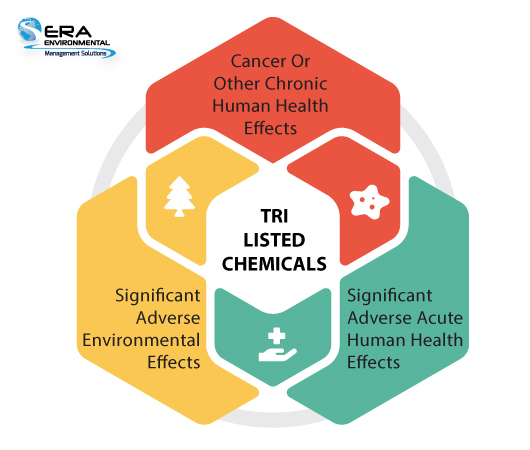TRI reporting season is upon us and now is the time to consider checking regulatory updates that relate to the TRI reportable chemicals that you use within your facility. Knowing the changes to regulations will help you avoid fines and maintain up-to-date records for TRI regulations and other environmental reporting.
This article will explore how chemical categories have evolved over time and how some easily overlooked changes appear in regulatory requirements.
How Many Chemicals are Regulated by TRI?
There is a long list of chemicals that are regulated under this program and the Clean Air Act (CAA). The TRI chemical list contains 33 chemical categories and 770 listed chemicals. Companies need to try their best to stay informed about the reportable chemicals and any changes that may occur. The EPA has a comprehensive list of chemicals they publish, but the chemical categories on that list can be confusing to understand. For example, the EPA has 187 chemicals on the HAP list but when you look more closely, these chemicals have subcategories that expand the list to over 5000 chemicals.
Therefore, you should investigate the full detailed chemical list and not simply rely on the surface chemical definitions on the EPA’s reportable chemical list. The general reportable chemicals usually cause the effects shown in the diagram below.

Evolution of Chemical Lists and Chemical Categories for TRI Reporting
Chemical regulatory lists undergo many changes as the EPA and other government agencies conduct experiments and investigations based on the group of chemicals. These changes come after careful evaluation and it is important to stay abreast of these to avoid reporting chemicals that have been removed from the lists and giving yourself unnecessary extra data tracking and compilation, or omitting a chemical that has recently been added or reclassified.
How the HAPS list has Evolved Over Time.
Some pollutants have been removed from the list of original HAPS. When a chemical is shown to have less severe effects on human and environmental health, the EPA can pass a rule to remove it from the list. Over the years, many experimental evaluations have shown that the following chemicals do not belong on the regulated EPA list of HAPs and VOCs anymore:
- In 2000, surfactant alcohol ethoxylates and their derivatives were removed from the glycol ethers category on the HAPS list based on the information provided by the Soap and Detergent Association (SDA). The EPA revised the definition of glycol ethers to exclude the removed compounds. This revision included defining glycol ethers by highlighting that the category includes mono- and di-ethers of ethylene glycol, diethylene glycol, and triethylene glycol R-(OCH2CH2) n-OR', where: n = 1, 2, or 3; R = alkyl C7 or less; or R = phenyl or alkyl substituted phenyl; R' = H or alkyl C7 or less; or OR’ consisting of carboxylic acid ester, sulfate, phosphate, nitrate, or sulfonate.
- In 2004, ethylene glycol monobutyl ether (EGBE) (2-Butoxyethanol) (CAS) No. 111-76-2 was removed from the group of Glycol ethers on the HAPS list because it was discovered that its effects are not adverse enough to warrant it being on the HAPS list.
Additions have also been made to the HAPS list based on evaluations of adverse effects of the compound.
- 1-bromopropane (1-BP), also known as n-propyl bromide (nPB), was added to the list of hazardous air pollutants in June 2020. This compound is a solvent in electronics and metal cleaning among other functions. Currently, there are no defined standards from sources because no regulatory requirements have been defined for it yet regarding environmental reporting.
How the PBT List has Evolved Over Time.
The Toxic Release Inventory program also covers some Persistent Bioaccumulative Toxic (PBT) Chemicals.
The list of bioaccumulative chemicals of concern has also evolved over time much like the HAPS list. These chemicals are of concern because they are toxic, and they also persist in the environment; therefore, they need strict regulation. The main change that this category has gone through is the lowering of reporting thresholds. The following chemicals and categories have had their thresholds lowered based on more evaluation on environmental persistence:
- In 2001, the EPA dropped reporting thresholds for lead and lead compounds to 100 pounds. This applied to all lead and lead compounds excluding lead that is in stainless steel, brass and bronze alloys.
- In 2016, the EPA added hexabromocyclododecane (HBCD) chemical category to the toxic chemicals list because research showed that it had reproductive and developmental consequences for humans and is harmful to aquatic organisms with a 100-pound threshold as a part of the PBT chemical list.
As of January 2021, The EPA added five PBTs to the list of chemicals. The Chemicals include:
- Decabromodiphenyl ether (DecaBDE)
- Phenol, isopropylated phosphate (3:1) (PIP (3:1))
- 2,4,6-Tris(tert-butyl) phenol (2,4,6-TTBP)
- Hexachlorobutadiene (HCBD)
- Pentachlorothiophenol (PCTP)
These chemicals have been regulated in various ways: for some, their use in manufacture has been prohibited and some have also been prohibited from commercial use. To learn more about these changes, the EPA has comprehensive reports on each ruling along with supporting research.
Addition of PFAS to the TRI List
For RY 2020 and beyond, the EPA added 172 polyfluoroalkyl substances (PFAS) to the Toxic Release Inventory chemical list. These are chemicals that are primarily used as water repellants in industry. These are being regulated at the state level as well in many states so it is essential for you to check how you should report them with your local agency.
The threshold for these substances is the same as for other chemicals at 100 pounds and the de minimis is 1 % for most PFAS except PFOA (CASRN: 335-67-1) which is classified as an OSHA carcinogen, therefore, its de minimis is 0.1%. If your facility uses PFAS, it is important to note how this addition will affect you.
Chemical categories and regulations often change and get updated, as highlighted within the three categories shown above. These changes need to be monitored closely by your environmental management team to ensure that you are properly reporting each chemical that is used within the facility. ERA’s master chemical list can keep track of these changes for you and automatically updates facility chemical lists.
Overlooked Items for TRI Reporting Regulatory Upkeep.
Additions and alterations to toxic chemical categories are important, but there are numerous updates that the EPA constantly makes to these reportable chemical lists. There are many small items that may be overlooked when you are tracking regulatory updates. These items are easily missed and require stringent monitoring from environmental management experts.
There are many types of chemical change adjustments that fall under this criteria. This section will outline these adjustments and give concrete 2020 reporting year examples to help you know what to keep an eye on when you are researching chemical changes.
The nature of these updates varies greatly, and it is important to keep track of them to avoid entering the wrong CAS number for a certain chemical or grouping different chemical states that should not be grouped together. The most commonly overlooked types of changes include:
- Changing and or correcting Chemical Abstracts Service Registry Numbers (CASRNs) and chemical names.
- Changes in chemical category definitions.
- Threshold changes according to further research as shown in the sections above.
- Regulatory text changes.
- Changes in de minimis values from 1% to 0.1% due to the classification of new carcinogens.
Changing and or Correcting Chemical Abstracts Service Registry Numbers (CASRNs) and Chemical Names
Entering the wrong CAS number in your report could result in you reporting the wrong chemical or wrong quantities for your facility. Keeping an eye on CAS number changes should be a regular practice when you are checking your regulatory requirements. For some chemicals, the full CAS number has changed - for example, the CASRN for yellow and white phosphorus was changed from 7723-14-0 to 12185-10-3 in the 2020 reporting year.
Another change to CAS numbers could be the addition of digits or minor adjustments. For example, two chemicals were missing CAS digits, and these CAS numbers were added to the EPA list: the chemicals are 1,6-dinitropyrene whose number is now (42397–64–8) and 1,8- dinitro pyrene - whose number is now (42397–65–9).
Chemical Category Changes
The major chemical category change from the 2020 reporting year is that the cyanide compounds category now excludes hydrogen cyanide. Hydrogen cyanide is still individually listed, so if your facility is required to report it, you must not report it under the cyanide compound category.
Threshold Changes
Chemical thresholds could also be adjusted based on their level of toxicity and persistence in the environment. As mentioned above, the reporting thresholds for certain PBTs were reduced when their toxicity was discovered to be more than expected. This is important to monitor because omission of a reportable chemical can lead to fines and other regulatory action. This important in ensuring continuous environmental safety.
Regulatory Text Changes
Dotting your ‘I’s and crossing ‘t’s is something that even regulatory organizations may miss in their regulatory documents. Some chemicals may have errors in their regulatory text names.
For example, in the 2020 TRI update, the formula for polychlorinated alkanes has changed from ‘‘CxH2x-y+2Cly,’ to ‘‘CxH2x-y+2 Cly” which puts the +2 in the superscript. A molecular formula was also corrected from ‘C10H19C13’’ to ‘‘C10H19Cl3’ to fix the typo where the ‘1’ is now an ‘l.’ This is a small change that could easily be missed especially the replacement of the ‘1’ with an ‘l’ in the regulatory text. Remember to keep an eye open for this type of small change when you are reading through EPA-regulated chemical lists and categories.
Changes in De Minimis Values
Monitoring the carcinogen classifications is important for knowing the chemicals whose de minimis has changed. Each year, there’s the potential for the de minimis for multiple chemicals to get updated. The changes occur because chemicals are classified as OSHA carcinogens by the International Agency for Research on Cancer (IARC) which means they should be further regulated.
For the 2020 reporting year, the de minimis for pyridine (110-86-1), methyl acrylate (96-33-3), quinoline (91-22-5), and vinylidene chloride (75-35-4) have changed from 1.0% to 0.1%. For the 2021 reporting year, the de minimis for 1,2-phenylenediamine (95-54-5) and 1,2-phenylenediamine dihydrochloride (615-28-1) will be changed from 1.0% to 0.1%.
A summary of these chemical changes is shown in the table below.
|
Type of TRI Chemical changes |
List of Changes |
|
Changes in de minimis values |
· the de minimis for pyridine (110-86-1) · methyl acrylate (96-33-3) · quinoline (91-22-5) · vinylidene chloride (75-35-4) · 1,2-phenylenediamine (95-54-5) · 1,2-phenylenediamine dihydrochloride (615-28-1) |
|
NEW CASR Numbers |
· yellow and white phosphorus is now 12185-10-3 · 1,6-dinitropyrene is now (42397–64–8) · 1,8- dinitro pyrene is now (42397–65–9) |
|
Added of EPA registry names |
· 1,4- bis(methylisocyanate)cyclohexane (CASRN 10347–54–3) · benzo[a]phenanthrene (CASRN 218–01– 9) · benzo[j,k]fluorene (CASRN 206–44– 0) · benzo[r,s,t]pentaphene (CASRN 189– 55–9) · dibenzo[a,h]anthracene (CASRN 53–70–3) |
|
Chemical Category Changes |
· Hydrogen cyanide is now excluded from cyanide compounds category |
|
Regulatory text corrections |
· ‘‘CxH2x-y+2Cly,’ to ‘‘CxH2x-y+2 Cly” · “C10H19C13’’ to ‘‘C10H19Cl3” |
Automating Chemical Regulatory Research
As you can see from all the changes outlined above, tracking these minor and major changes can be extremely time-consuming. Some changes are so microscopic such as the change from a ‘1’ to an ‘l’ that it would take a significant amount of time to update these each reporting year. Automating the process is the best way to improve your TRI reporting process. Some of the changes are minute and can be easily missed when filing your TRI reports.
How Having a Master Chemical List Can Help You
Imagine not having to worry about all the changes and advances discussed above. When your environmental reporting is automated, you do not need to think about all these changes because ERA’s master chemical list monitors changes to chemical regulations and automatically updates them every night. Some regulatory bodies make these changes more frequently and this means monitoring them may feel like playing whack-a-mole.
ERA’s master chemical list houses more than 160 000 chemicals and their regulatory information. With ERA’s MCL, your facility can:
- Automatically track regulatory updates and data.
- Confirm the accuracy of regulatory data.
- Reduce time spent on regulatory research.
- Eliminate the need for purchasing external chemical lists.
Learn more about how the MCL is monitored, maintained, and used for regulatory reporting in ERA’s MCL case study eBook.
This Blog was Co-Authored By:




Comments